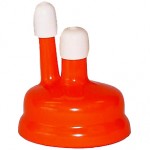Here's an early update:
The beer is a super clear, ruby red with a lot of character. The recipe is in this thread somewhere.
The beer just started to show signs of proper lacing last night, and a small amount of hop aroma has returned, surprisingly enough.
So, to go from "Wow!", to absolute tasteless, metallic band aid, back to, "Hey! This is pretty good!" took 90 hours.
I drank three glasses (about two pints-worth) last night, and I felt very nice. Perhaps/hopefully tonight it will be even better.
All that said, I am still not completely happy. Although the initial metallic bite is subsiding, and I have accepted my net loss in hoppiness, somehow there is still some kind of off flavor that disappoints me. It's the same one I was complaining about initially, but letting the CO2 settle has somehow unpublicized it. Some kind of astringent "thinness" that's hard to put my finger on is still lingering there, and based on my experience, it is not going to go away. I believe the keg will empty while still showing signs of it. It is preventing my beer from tasting "pro". Perhaps this is the flaw in my water.
So! Early impressions to all your guys' input are that just about EVERYONE was right.
I have this full keg to go through, and I have another beer in the basement (unfortunately not treated with Campden either). As soon as I tap that beer in the basement, I'll brew my next batch, which should be within a month, so I'll most likely be able to share my Campden findings within the next six weeks. Thank you all for your time!

The beer is a super clear, ruby red with a lot of character. The recipe is in this thread somewhere.
The beer just started to show signs of proper lacing last night, and a small amount of hop aroma has returned, surprisingly enough.
So, to go from "Wow!", to absolute tasteless, metallic band aid, back to, "Hey! This is pretty good!" took 90 hours.
I drank three glasses (about two pints-worth) last night, and I felt very nice. Perhaps/hopefully tonight it will be even better.
All that said, I am still not completely happy. Although the initial metallic bite is subsiding, and I have accepted my net loss in hoppiness, somehow there is still some kind of off flavor that disappoints me. It's the same one I was complaining about initially, but letting the CO2 settle has somehow unpublicized it. Some kind of astringent "thinness" that's hard to put my finger on is still lingering there, and based on my experience, it is not going to go away. I believe the keg will empty while still showing signs of it. It is preventing my beer from tasting "pro". Perhaps this is the flaw in my water.
So! Early impressions to all your guys' input are that just about EVERYONE was right.
- Dropping the temp forced the yeast to drop out of suspension, along with a lot of flavor-masking hop particles
- Pushing higher-than-serving PSI onto the beer yields a very metallic and chemical flavor between the second and fourth days, possibly over-signaling the beer's less desirable attributes
- Once the CO2 starts to properly absorb, the hop aroma begins to return, but as to be expected, never gets back to the glory aroma of the beer's warmer carboy days
- Too early to tell, but the remaining off flavor might be able to be solved with Campden
I have this full keg to go through, and I have another beer in the basement (unfortunately not treated with Campden either). As soon as I tap that beer in the basement, I'll brew my next batch, which should be within a month, so I'll most likely be able to share my Campden findings within the next six weeks. Thank you all for your time!
















![Craft A Brew - Safale S-04 Dry Yeast - Fermentis - English Ale Dry Yeast - For English and American Ales and Hard Apple Ciders - Ingredients for Home Brewing - Beer Making Supplies - [1 Pack]](https://m.media-amazon.com/images/I/41fVGNh6JfL._SL500_.jpg)











































